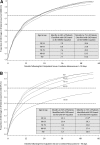Implications of the CKD-EPI GFR estimation equation in clinical practice
- PMID: 21115622
- PMCID: PMC3082406
- DOI: 10.2215/CJN.04240510
Implications of the CKD-EPI GFR estimation equation in clinical practice
Abstract
Background and objectives: Chronic kidney disease (CKD) is a significant public health problem whose diagnosis and staging relies upon GFR-estimating equations, including the new CKD-EPI equation. CKD-EPI demonstrated superior performance compared with the existing MDRD equation but has not been applied to a healthcare system.
Design, setting, participants, & measurements: We identified 53,759 patients with stages 3 to 5 CKD on the basis of either MDRD or CKD-EPI equations using two eGFR values <60 ml/min per 1.73 m² > 90 days apart from an outpatient setting. We compared patient characteristics, presence of related diagnosis codes, and time CKD classification between equations.
Results: The number of patients identified with CKD decreased 10% applying CKD-EPI versus MDRD. Changes varied substantially by patient characteristics including a 35% decrease among patients < 60 years and a 10% increase among patients > 90 years. Women, non-African Americans, nondiabetics, and obese patients were less likely to be classified on the basis of CKD-EPI. Time to CKD classification was significantly longer with CKD-EPI among younger patients. 14% of patients identified with CKD on the basis of either estimating equation also had a related ICD-9 diagnosis, ranging from 19% among patients < 60 years to 7% among patients > 90 years.
Conclusions: Consistent with findings in the general population, CKD-EPI resulted in substantial declines in equation-based CKD diagnoses in a large healthcare system. Further research is needed to determine whether widespread use of CKD-EPI with current guidelines could lead to delayed needed care among younger patients or excessive referrals among older patients.
Figures


References
-
- Coresh J, Selvin E, Stevens LA, Manzi J, Kusek JW, Eggers P, Van Lente F, Levey AS: Prevalence of chronic kidney disease in the United States. JAMA 298: 2038–2047, 2007 - PubMed
-
- Levey AS, Andreoli SP, DuBose T, Provenzano R, Collins AJ: CKD: common, harmful, and treatable: World Kidney Day 2007. Am J Kidney Dis 49: 175–179, 2007 - PubMed
-
- Noordzij M, Korevaar JC, Boeschoten EW, Dekker FW, Bos WJ, Krediet RT: The Kidney Disease Outcomes Quality Initiative (K/DOQI) Guideline for Bone Metabolism and Disease in CKD: Association with mortality in dialysis patients. Am J Kidney Dis 46: 925–932, 2005 - PubMed
-
- Levin A: Clinical epidemiology of cardiovascular disease in chronic kidney disease prior to dialysis. Semin Dial 16: 101–105, 2003 - PubMed
Publication types
MeSH terms
LinkOut - more resources
Full Text Sources
Medical
Research Materials
Miscellaneous

